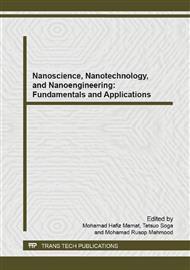[1]
S. Iijima, Helical microtubules of graphitic carbon, Nature 354 (1991) 56-58.
DOI: 10.1038/354056a0
Google Scholar
[2]
S. Iijima, T. Ichihashi, Single-shell carbon nanotubes of 1-nm diameter, Nature 363 (1993) 603-605.
DOI: 10.1038/363603a0
Google Scholar
[3]
S.P. Chai, W.W. Liu, K.Y. Lee, W.M. Yeoh, V.M. Sivakumar, A.R. Mohamed, Effect of FeOx loaded on CoOx/Al2O3 catalyst for the formation of thin-walled carbon nanotubes, Materials Letters 63 (2009) 1428-1430.
DOI: 10.1016/j.matlet.2009.03.019
Google Scholar
[4]
W.W. Liu, T. Adam, A. Aziz, S.P. Chai, A.R. Mohamed, U. Hashim, Formation of carbon nanotubes from methane decomposition: Effect of concentration of Fe3O4 on the diameters distributions, Advanced Materials Research 832 (2014) 62-67.
DOI: 10.4028/www.scientific.net/amr.832.62
Google Scholar
[5]
W.W. Liu, T. Adam, A. Aziz, S.P. Chai, A.R. Mohamed, U. Hashim, A study on the effect of calcination temperature on the graphitization of carbon nanotubes synthesized by the decomposition of methane, Advanced Materials Research 832 (2014) 56-61.
DOI: 10.4028/www.scientific.net/amr.832.56
Google Scholar
[6]
W.W. Liu, A. Aziz, S.P. Chai, A.R. Mohamed, U. Hashim, Synthesis of single-walled carbon nanotubes: Effects of active metals, catalyst supports, and metal loading percentage, Journal of Nanomaterials 2013 (2013).
DOI: 10.1155/2013/592464
Google Scholar
[7]
W.W. Liu, A. Aziz, S.P. Chai, A.R. Mohamed, C.T. Tye, The effect of carbon precursors (methane, benzene and camphor) on the quality of carbon nanotubes synthesised by the chemical vapour decomposition, Physica E: Low-Dimensional Systems and Nanostructures 43 (2011) 1535-1542.
DOI: 10.1016/j.physe.2011.05.012
Google Scholar
[8]
W.W. Liu, A. Aziz, S.P. Chai, A.R. Mohamed, C.T. Tye, Optimisation of reaction conditions for the synthesis of single-walled carbon nanotubes using response surface methodology, Canadian Journal of Chemical Engineering 90 (2012) 489-505.
DOI: 10.1002/cjce.20561
Google Scholar
[9]
W.W. Liu, A. Aziz, S.P. Chai, C.T. Tye, A.R. Mohamed, Broad bundles of single-walled carbon nanotube synthesized over Fe2O3/MgO via chemical vapor deposition of methane, Nano 4 (2009) 77-81.
DOI: 10.1142/s1793292009001526
Google Scholar
[10]
W.W. Liu, A. Aziz, S.P. Chai, A.R. Mohamed, C.T. Tye, Preparation of iron oxide nanoparticles supported on magnesium oxide for producing high-quality single-walled carbon nanotubes, Xinxing Tan Cailiao/New Carbon Materials 26 (2011) 255-261.
DOI: 10.1016/s1872-5805(11)60080-2
Google Scholar
[11]
S.M. Tan, Chai SP, W.W. Liu, A.R. Mohamed, Effects of FeOx, CoOx, and NiO catalysts and calcination temperatures on the synthesis of single-walled carbon nanotubes through chemical vapor deposition of methane, Journal of Alloys and Compounds 477 (2009) 785-788.
DOI: 10.1016/j.jallcom.2008.10.114
Google Scholar
[12]
J.H. Teong Ooi, W.W. Liu, V. Thota, A.R. Mohamed, S.P. Chai, Synthesis of single-walled carbon nanotubes by chemical vapor deposition using sodium chloride support, Physica E: Low-Dimensional Systems and Nanostructures 43 (2011) 1011-1014.
DOI: 10.1016/j.physe.2010.12.003
Google Scholar
[13]
D. Tasis D, N. Tagmatarchis, V. Georgakilas, M. Prato M, Soluble carbon nanotubes, Chem.Eur. J. 9 (2003) 4000–4008.
DOI: 10.1002/chem.200304800
Google Scholar
[14]
J. Hilding, E.A. Grulke, Z. George, F. Lockwood, Dispersion of nanotube in Liquid, Journal of Dispersion Science and Technology 24 (2003) 1–41.
DOI: 10.1081/dis-120017941
Google Scholar
[15]
L. Vaisman, H.D. Wagner, G. Marom, The role of surfactants in dispersion of carbon nanotubes, Adv. Colloid Interface Sci. 128–130 (2006) 37–46.
DOI: 10.1016/j.cis.2006.11.007
Google Scholar
[16]
M.S. Strano, V.C. Moore, M.K. Miller, M.J. Allen, E.H. Haroz, C. Kittrell, R.H. Hauge, R.E. Smalley, The role of surfactant adsorption during ultrasonication in the dispersion of single-walled carbon nanotubes, J. Nanosci. Nanotechnol. 3 (2003) 81-86.
DOI: 10.1166/jnn.2003.194
Google Scholar
[17]
M.F. Islam, E. Rojas, D.M. Bergey, A.T. Johnson, A.G. Yodh, High weight fraction surfactant solubilization of single-wall carbon nanotubes in water, Nano Lett. 3 (2003) 269-273.
DOI: 10.1021/nl025924u
Google Scholar
[18]
R. Rastogi, R. Kaushal, S.K. Tripathi, A.M. Sharma, I. Kaur, L.M. Bharadwaj, Comparative study of carbon nanotube dispersion using surfactants, J. Colloid Interface Sci. 328 (2008) 421-428.
DOI: 10.1016/j.jcis.2008.09.015
Google Scholar


